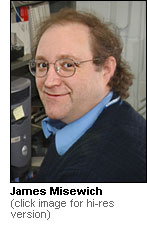Carbon Nanotubes with Big Possibilities
March 25, 2004
NOTE TO EDITORS: This press release describes a talk being given by a scientist from the U.S. Department of Energy's Brookhaven National Laboratory at the March 2004 meeting of the American Physical Society, taking place March 22-26 at the Palais de Congres, Montreal, Canada (http://www.aps.org/meet/MAR04/). This information is embargoed for release at the time of the talk.
MONTREAL, CANADA - A scientist at the U.S. Department of Energy's Brookhaven National Laboratory, working with colleagues at the IBM T.J. Watson Research Center, has caused an individual carbon nanotube to emit light for the first time. This step in research on carbon nanotubes may help to materialize many of the proposed applications for carbon nanotubes, such as in electronics and photonics development.
The light emission is the result of a process called "electron-hole recombination." By running an electric current through a carbon nanotube - a long, hollow cylindrical molecule that is only one and a half nanometers (a billionth of a meter) in diameter - negatively charged electrons in the nanotube molecule combine with positively charged "holes," which are locations in the molecule where electrons are missing. When an electron fills a hole, it emits a photon - a tiny burst of light.
"We produced infrared light by applying voltages to a specific type of nanotube such that many electrons and holes end up in the nanotube, where they combine. This makes the nanotube the world's smallest electrically-controllable light emitter," said James Misewich, a materials scientist at Brookhaven. "It's an exciting result, and my colleagues and I plan to continue studying the effect to determine the mechanisms behind it. For example, we hope to understand how to make the nanotubes emit other types of light, such as visible light, and how to increase the efficiency of the emission." Carbon nanotubes do not yet have any mainstream practical applications, but researchers are investigating ways to use them in flat-panel displays, such as televisions and computer monitors, or as reinforcements in building materials, due to their exceptional mechanical strength. Misewich also suggested that, if additional research leads to an increased efficiency of nanotube light emission, the nanotubes could possibly be used in lighting applications.
Misewich will present his research in the "Optoelectronics in Nanoscale Devices" session on Thursday, March 25 at 8 a.m. in room 520F. The research is funded by the Department of Energy's Office of Basic Energy Sciences within the Office of Science.
2004-10119 | INT/EXT | Newsroom










